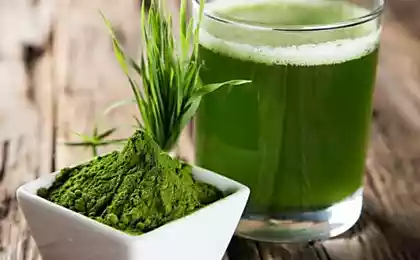470
Luxury product to rejuvenate the body
Spirulina is a type of blue-green algae, which is an incredible super product that provides a concentrated source of protein, vitamins, antioxidants and other nutrients. This is one of the oldest forms of life on Earth – its use as a food source dates back to the 9th century. It is believed that spirulina was used by the Aztecs in 16th century Mexico.
Spirulina (a type of single-celled organisms) got its name from the Latin word "spiral" due to its physical properties similar to spiral. Spirulina is known mainly as a food additive or ingredient to add nutrients to smoothies and green drinks. But in some parts of the world spirulina is considered a valuable food source to prevent malnutrition.
Why spirulina is superstar power?Although spirulina is often described as "blue green algae", technically, is a species of cyanobacteria. Cyanobacteria are bacteria because their genetic material is not organized in a membrane-bound nucleus. Unlike other bacteria, they have chlorophyll and use the sun as an energy source, as well as plants and algae.
One of the special characteristics of spirulina yavlyaetsyato content of protein is 50 to 70% by weight (even more than in red meat – there are protein is about 27% by weight). It also contains all the essential amino acids and 10 of the 12 non-essential amino acids, along with a whole host of other beneficial nutrients such as:
B vitamins (including exceptionally high levels of vitamin B-12), vitamin K and other vitamins Naturally high level of iodineMinerals (including calcium, iron, magnesium, selenium, manganese, potassium and zinc) One of best known sources of gamma-linolenic acid (GLA, important for the heart and joints fatty acid) and Other essential fatty acids, including sulfolipids, which may have a protective effect against HIV infection of T-helper cells the Phytopigments (phycocyanin, chlorophyll and carotenoids) Compounds metal-tionin (proteins combined with metals that bind heavy radioactive isotopes) Low in carbohydrates (15-20%) 18 various amino acidsin addition, spirulina has many unique properties:

So, organization is "Antenna India" offers "sweetness" of spirulina for children at risk of malnutrition, and low-cost spirulina to women in self-help groups, which can then sell this super product with a view to profit, while raising awareness about eating disorders.
In children who received daily supplements with spirulina, five days a week for two months improved nutritional and intellectual status compared to those who did not receive such supplements.
Nutrient density of spirulina is so high that NASA and the European space Agency are exploring the possibility of its inclusion in the diet of astronauts in spacecraft and on Mars.
Even beyond nutrition, spirulina offers many benefits to the environment and those who grow it. For example, for the production of spirulina requires 10 times less water than other vegetables, and to harvest all year round.
Spirulina: boosts the immune system, reduces inflammation and fights with chronic diseasesthe Use of spirulina for health is enormous and touches almost every area of the body. For example, spirulina is very promising for people with cardiovascular disease, from the point of view of improving lipid profiles, control hypertension, and improve the elasticity of blood vessels.
Animal studies show that spirulina can protect the liver, probably as a result of its high antioxidant properties and ability to synthesize or release nitric oxide, and in the study of three antioxidant-rich foods (blueberries, spinach and spirulina), it was found that spirulina has the highest neuroprotective effect, possibly due to its ability to quench free radicals and reduce inflammation.
In addition, it is proved that spirulina okazyvayutsya effect for many common conditions – from arsenic poisoning to allergies. According to one study, patients treated with spirulina reported relief of symptoms commonly associated with allergic rhinitis such as nasal discharge, nasal congestion, sneezing and itching. Moreover, the conducted research supporting the potential application of spirulina for the prevention and/or treatment of the following diseases:
Age-related macular degeneration type 2 Diabetes, cardiovascular disease, including hypertension non-Alcoholic fatty liver liver Health and reducing damage from exposure to heavy metals violations of cerebral circulation, including stroke, eating Disorders such as iron deficiency anemia (vitamin B12 deficiency), vitamin a deficiency and kwashiorkor Neurodegenerative disorders such as Parkinson's and Alzheimer's Protection against HIV and other viruses reducing the symptoms of Allergy Protection from cancer and radiation Protection Health bone marrow and blood (especially during use of anticancer drugs) Strengthening immune defenses and modulating inflammatory response Reduced pain sensitivity by inhibiting prostaglandins that contribute to pain and inflammation Reduction of arthritis symptoms Protection from the damage caused by ionizing radiation spirulina Safety: beware of contaminationSpirulina record safe even in high doses, and about side effects reported are very few. But if it is collected in polluted water or grown incorrectly, it can accumulate toxins from the environment. Ideally, only consume organic spirulina from a trusted source, grown in waters contaminated by hazardous substances.

If you are going to start taking spirulina on the scheme, the recommended prophylactic dose is 3,000 milligrams (mg) per day for adults, and from 500 to 1,500 mg for children. For therapeutic use in adults is required from 10000 to as much as 20,000 mg per day. But remember: besides the fact that spirulina is a storehouse of essential vitamins and minerals, it is also a powerful detoxifier. Therefore, it is best to start with a small dose and increase it gradually. When you see how your body reacts, you will be able to gradually increase its consumption.
Again, despite the fact that side effects are minimal, you may experience the following reactions:
Author: Dr. Joseph Mercola
P. S. And remember, only by changing their consumption — together we change the world! ©
Source: russian.mercola.com/sites/articles/archive/2016/09/19/%D1%81%D0%B2%D0%BE%D0%B8%D1%81%D1%82%D0%B2%D0%B0-%D1%81%D0%BF%D0%B8%D1%80%D1%83%D0%BB%D0%B8%D0%BD%D1%8B.aspx
Spirulina (a type of single-celled organisms) got its name from the Latin word "spiral" due to its physical properties similar to spiral. Spirulina is known mainly as a food additive or ingredient to add nutrients to smoothies and green drinks. But in some parts of the world spirulina is considered a valuable food source to prevent malnutrition.
Why spirulina is superstar power?Although spirulina is often described as "blue green algae", technically, is a species of cyanobacteria. Cyanobacteria are bacteria because their genetic material is not organized in a membrane-bound nucleus. Unlike other bacteria, they have chlorophyll and use the sun as an energy source, as well as plants and algae.
One of the special characteristics of spirulina yavlyaetsyato content of protein is 50 to 70% by weight (even more than in red meat – there are protein is about 27% by weight). It also contains all the essential amino acids and 10 of the 12 non-essential amino acids, along with a whole host of other beneficial nutrients such as:
B vitamins (including exceptionally high levels of vitamin B-12), vitamin K and other vitamins Naturally high level of iodineMinerals (including calcium, iron, magnesium, selenium, manganese, potassium and zinc) One of best known sources of gamma-linolenic acid (GLA, important for the heart and joints fatty acid) and Other essential fatty acids, including sulfolipids, which may have a protective effect against HIV infection of T-helper cells the Phytopigments (phycocyanin, chlorophyll and carotenoids) Compounds metal-tionin (proteins combined with metals that bind heavy radioactive isotopes) Low in carbohydrates (15-20%) 18 various amino acidsin addition, spirulina has many unique properties:
- Proteins in spirulina is very easily digested (83 to 90%), due to the fact that it does not have cellulose walls, like yeast and Chlorella. Thus, the net protein digestibility (CHUB) is high (53 to 61%) and does not require cooking to improve its bioavailability.
- Studies confirm a very high "protein efficiency ratio" (CAB) of spirulina, and this means that your body can efficiently use these amino acids.
- This high level of gamma-linolenic acid is rarely found in ANY food and, as a rule, is synthesized in the body from linoleic acid. GLA is a precursor of important biochemical substances such as prostaglandins, leukotrienes and thromboxanes that serve as chemical mediators of inflammatory and immune reactions.
- In spirulina has no fatty acids with odd numbers of carbon atoms and fatty acids with very little branched chain is two types of lipids that higher animals, like you, do not learn.
- The contents of calcium, phosphorus and magnesium in spirulina is about the same as in milk, the level of vitamin E (tocopherol) is comparable to wheat germ, and vitamin B12 in it four times more than in raw liver!

So, organization is "Antenna India" offers "sweetness" of spirulina for children at risk of malnutrition, and low-cost spirulina to women in self-help groups, which can then sell this super product with a view to profit, while raising awareness about eating disorders.
In children who received daily supplements with spirulina, five days a week for two months improved nutritional and intellectual status compared to those who did not receive such supplements.
Nutrient density of spirulina is so high that NASA and the European space Agency are exploring the possibility of its inclusion in the diet of astronauts in spacecraft and on Mars.
Even beyond nutrition, spirulina offers many benefits to the environment and those who grow it. For example, for the production of spirulina requires 10 times less water than other vegetables, and to harvest all year round.
Spirulina: boosts the immune system, reduces inflammation and fights with chronic diseasesthe Use of spirulina for health is enormous and touches almost every area of the body. For example, spirulina is very promising for people with cardiovascular disease, from the point of view of improving lipid profiles, control hypertension, and improve the elasticity of blood vessels.
Animal studies show that spirulina can protect the liver, probably as a result of its high antioxidant properties and ability to synthesize or release nitric oxide, and in the study of three antioxidant-rich foods (blueberries, spinach and spirulina), it was found that spirulina has the highest neuroprotective effect, possibly due to its ability to quench free radicals and reduce inflammation.
In addition, it is proved that spirulina okazyvayutsya effect for many common conditions – from arsenic poisoning to allergies. According to one study, patients treated with spirulina reported relief of symptoms commonly associated with allergic rhinitis such as nasal discharge, nasal congestion, sneezing and itching. Moreover, the conducted research supporting the potential application of spirulina for the prevention and/or treatment of the following diseases:
Age-related macular degeneration type 2 Diabetes, cardiovascular disease, including hypertension non-Alcoholic fatty liver liver Health and reducing damage from exposure to heavy metals violations of cerebral circulation, including stroke, eating Disorders such as iron deficiency anemia (vitamin B12 deficiency), vitamin a deficiency and kwashiorkor Neurodegenerative disorders such as Parkinson's and Alzheimer's Protection against HIV and other viruses reducing the symptoms of Allergy Protection from cancer and radiation Protection Health bone marrow and blood (especially during use of anticancer drugs) Strengthening immune defenses and modulating inflammatory response Reduced pain sensitivity by inhibiting prostaglandins that contribute to pain and inflammation Reduction of arthritis symptoms Protection from the damage caused by ionizing radiation spirulina Safety: beware of contaminationSpirulina record safe even in high doses, and about side effects reported are very few. But if it is collected in polluted water or grown incorrectly, it can accumulate toxins from the environment. Ideally, only consume organic spirulina from a trusted source, grown in waters contaminated by hazardous substances.

If you are going to start taking spirulina on the scheme, the recommended prophylactic dose is 3,000 milligrams (mg) per day for adults, and from 500 to 1,500 mg for children. For therapeutic use in adults is required from 10000 to as much as 20,000 mg per day. But remember: besides the fact that spirulina is a storehouse of essential vitamins and minerals, it is also a powerful detoxifier. Therefore, it is best to start with a small dose and increase it gradually. When you see how your body reacts, you will be able to gradually increase its consumption.
Again, despite the fact that side effects are minimal, you may experience the following reactions:
- Easy fever - a high protein content in spirulina increases metabolism, which can increase body temperature.
- Chair dark green - spiruline output accumulated in the colon waste, resulting in a chair may become a darker color.
- Excessive gas - this may mean that your digestive system is not functioning properly or you have an accumulation of excess gases.
- Agitation or somnolence – your body converts protein into heat energy, which may cause temporary feelings of restlessness. On the other hand, the detoxification process can also cause drowsiness, which may indicate that your body is exhausted and needs rest.
- Rashes and skin irritation is linked to the process of colon cleansing and is only temporary.
Author: Dr. Joseph Mercola
P. S. And remember, only by changing their consumption — together we change the world! ©
Source: russian.mercola.com/sites/articles/archive/2016/09/19/%D1%81%D0%B2%D0%BE%D0%B8%D1%81%D1%82%D0%B2%D0%B0-%D1%81%D0%BF%D0%B8%D1%80%D1%83%D0%BB%D0%B8%D0%BD%D1%8B.aspx























